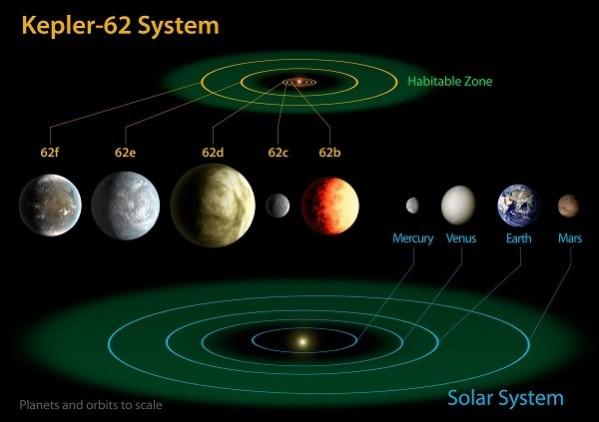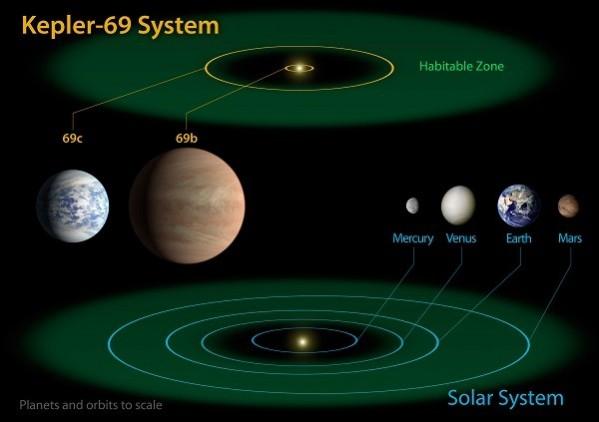
NASA's Kepler space telescope has discovered three new super-Earth-size exoplanets in the habitable zone - range of distance from a star where the surface temperature is suitable for liquid water to exist.
The Kepler mission has found two planetary systems - Kepler-62 system and Kepler-69 system.
Kepler-62 has five planets- 62b, 62c, 62d, 62e and 62f. They orbit a star called K2 dwarf, which measures just two-thirds the size of the sun. It is about 1,200 light-years from Earth in the constellation Lyra.

Kepler-69 has two planets 69b and 69c. Of the seven exoplanets, three of them - 62e, 62f and 69c - are super-Earth-sized exoplanets located in the so-called Goldilocks position (habitable zone).
Kepler-62f is just 1.4 times (40 percent) larger than the Earth, while Kepler-62e is about 1.6 times (60 percent) larger than our planet. The third exoplanet - Kepler-69c - is about 70 percent larger than the size of Earth. The planet is orbiting in the habitable zone of a star that is similar to our sun. Kelpler-69c has an orbital period of 242 days which resembles Earth's neighboring planet Venus.
It is not known if the newly-found exoplanets could support life, but the discoveries are a significant step in finding a world similar to Earth that orbits a star like our sun, according to NASA scientists.
"The Kepler spacecraft has certainly turned out to be a rock star of science," John Grunsfeld, associate administrator of the Science Mission Directorate at NASA Headquarters in Washington, said in a statement.
"The discovery of these rocky planets in the habitable zone brings us a bit closer to finding a place like home. It is only a matter of time before we know if the galaxy is home to a multitude of planets like Earth, or if we are a rarity."
Kepler-62e was the first habitable zone planet to be identified by the Kepler space telescope. The exoplanet orbits its parent star every 122 days. Eric Agol, associate professor of astronomy at the University of Washington, found Kepler-62f with an orbital period of 267 days.
The habitable zone planets in Kepler-62 planetary system have three companions that orbits close to their star. While two of them are larger than the size of the Earth, the third one is about the size of Mars. Kepler-62b, Kepler-62c and Kepler-62d orbit their parent star every five, 12, and 18 days, respectively.
Kepler 69c in the Kepler-69 planetary system has a companion - Kepler-69b - that is more than twice the size of the Earth and orbits around its star every 13 days. Their host star resembles our sun and belongs to the same class called G-type. It is 93 percent the size of the sun and 80 percent as bright. The sun-like star is located about 2,700 light-years from Earth in the constellation Cygnus.
"We only know of one star that hosts a planet with life, the sun. Finding a planet in the habitable zone around a star like our sun is a significant milestone toward finding truly Earth-like planets," said Thomas Barclay, Kepler scientist at the Bay Area Environmental Research Institute in Sonoma, Calif.
The details of the discoveries of the Kepler-62 system are published in the journal Science. The findings of the Kepler-69 system are published in the journal Astrophysical Journal.









